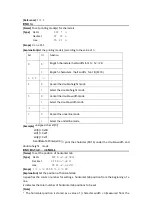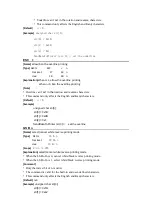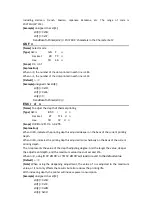
0 ≤nL ≤255
0 ≤nH ≤1
0 ≤d ≤255
[Explanation]
This command can only print the black/white bit-image whose height is 8 dots or 24 dots and
width does not exceed the printable area.
The parameter meaning is as follows:
Using the m to select the bit image modes, and the dots of the bit image in the horizontal
direction are specified by the nL and Nh.
m
The number of vertical dots
(height)
Double-width mode
0
8
Twice as width
1
8
single-width
32
24
Twice as width
33
24
single-width
The nL and nH are the low and high bit of double-byte unsigned integer N. They express the
number of the dots of the bit-image on the horizontal direction.
Mode 1: When the double-width mode is single-width, its maximum is 384. When the
double-width mode is twice as width, its maximum is 192.
Mode 2: When the double-width mode is single-width, its maximum is 432. When the
double-width mode is twice as width, its maximum is 216.
d1……dk
express the bit-image data. And the specific format is as follows:
[Example 1]
m =0 (8 dots, t
wice as width), d1 represents the data to be printed in the first
and second column. And dk represents the data to be printed in the 2k
th
and (2k-1)
th
column. The bn represents the n
th
bit of the byte.
Program code is as follows:
unsigned char str[100];
j=0;
str [j++] = 0x1B;
str r[j++] = 0x2A;
d1 d2 d3 d4 d5 d6 d7 d8
0
1
1
1
1
1
0
0
b7
0
0
1
0
0
0
1
0
b6
0
0
1
0
0
0
1
0
b5
0
0
1
1
1
1
0
0
b4
0
0
1
0
1
0
0
0
b3
0
0
1
0
0
1
0
0
b2
0
0
1
0
0
1
0
0
b1
0
0
1
0
0
0
1
0
b0
Summary of Contents for RD-FH8C7
Page 41: ...B character set 1 and 2 C International standard ASCII ...
Page 43: ......
















































